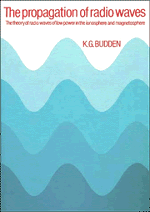 The Propagation of Radio Waves
The Propagation of Radio Waves Book contents
- Frontmatter
- Contents
- Preface
- 1 The ionosphere and magnetosphere
- 2 The basic equations
- 3 The constitutive relations
- 4 Magnetoionic theory 1. Polarisation and refractive index
- 5 Magnetoionic theory 2. Rays and group velocity
- 6 Stratified media. The Booker quartic
- 7 Slowly varying medium. The W.K.B. solutions
- 8 The Airy integral function and the Stokes phenomenon
- 9 Integration by steepest descents
- 10 Ray tracing in a loss-free stratified medium
- 11 Reflection and transmission coefficients
- 12 Ray theory results for isotropic ionosphere
- 13 Ray theory results for anisotropic plasmas
- 14 General ray tracing
- 15 Full wave solutions for isotropic ionosphere
- 16 Coupled wave equations
- 17 Coalescence of coupling points
- 18 Full wave methods for anisotropic stratified media
- 19 Applications of full wave methods
- Answers to problems
- Bibliography
- Index of definitions of the more important symbols
- Subject and name index
18 - Full wave methods for anisotropic stratified media
Published online by Cambridge University Press: 06 December 2010
- Frontmatter
- Contents
- Preface
- 1 The ionosphere and magnetosphere
- 2 The basic equations
- 3 The constitutive relations
- 4 Magnetoionic theory 1. Polarisation and refractive index
- 5 Magnetoionic theory 2. Rays and group velocity
- 6 Stratified media. The Booker quartic
- 7 Slowly varying medium. The W.K.B. solutions
- 8 The Airy integral function and the Stokes phenomenon
- 9 Integration by steepest descents
- 10 Ray tracing in a loss-free stratified medium
- 11 Reflection and transmission coefficients
- 12 Ray theory results for isotropic ionosphere
- 13 Ray theory results for anisotropic plasmas
- 14 General ray tracing
- 15 Full wave solutions for isotropic ionosphere
- 16 Coupled wave equations
- 17 Coalescence of coupling points
- 18 Full wave methods for anisotropic stratified media
- 19 Applications of full wave methods
- Answers to problems
- Bibliography
- Index of definitions of the more important symbols
- Subject and name index
Summary
Introduction
This chapter deals with problems where the approximations of ray theory cannot be used and where it is necessary to take account of the anisotropy of the medium. It is therefore mainly concerned with low and very low frequencies, so that the change of the medium within one wavelength is large. The problem is discussed here for the ionosphere, which is assumed to be a plane stratified plasma in the earth's magnetic field. A radio wave of specified polarisation is incident obliquely and it is required to find the reflection coefficient as defined in §§ 11.2–11.6. In some problems it is also required to find the transmission coefficients. It is therefore necessary to find solutions of the governing differential equations, and the form used here is (7.80), (7.81). This type of problem has been very widely studied and there are many methods of tackling it and many different forms of the differential equations. These methods are too numerous to be discussed in detail, but the main features of some of them are given in §§ 18.3–18.5. The object in this chapter is to clarify the physical principles on which the various operations are based, and for this the equations (7.80), (7.81) are a useful starting point. In a few cases solutions can be expressed in terms of known functions, and some examples are given in §§ 19.2–19.6.
- Type
- Chapter
- Information
- The Propagation of Radio WavesThe Theory of Radio Waves of Low Power in the Ionosphere and Magnetosphere, pp. 550 - 582Publisher: Cambridge University PressPrint publication year: 1985
